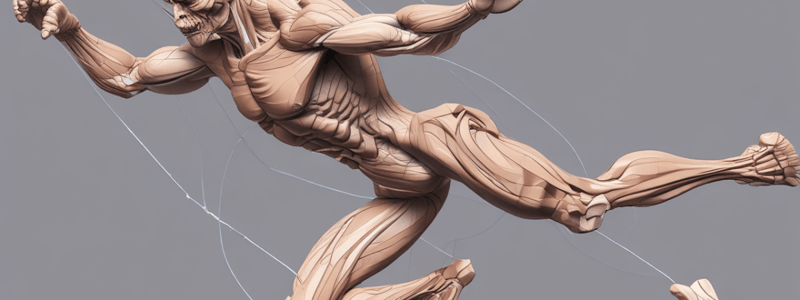Podcast
Questions and Answers
What is the primary function of agonist muscles?
What is the primary function of agonist muscles?
- To control the movement of a joint
- To produce the primary movement or action (correct)
- To stabilize the body
- To oppose the action of other muscles
What is the role of antagonist muscles?
What is the role of antagonist muscles?
- To stabilize the body
- To oppose the action of agonist muscles (correct)
- To produce the primary movement or action
- To generate force and movement
What is the first step in movement analysis?
What is the first step in movement analysis?
- Analyze the movement pattern and muscle activation
- Determine the joints involved and their movements
- Identify the movement or skill (correct)
- Identify the agonist and antagonist muscles involved
Which muscle is an agonist in knee extension?
Which muscle is an agonist in knee extension?
What is the purpose of analyzing a movement or skill?
What is the purpose of analyzing a movement or skill?
Which muscle is an antagonist in elbow flexion?
Which muscle is an antagonist in elbow flexion?
What is the last step in movement analysis?
What is the last step in movement analysis?
What is the term for the primary muscles responsible for producing movement?
What is the term for the primary muscles responsible for producing movement?
Study Notes
Muscular Involvement in Physical Education
Agonist Muscles
- Also known as prime movers, these muscles are responsible for producing the primary movement or action
- Contract to generate force and movement
- Examples:
- Bicep brachii in elbow flexion
- Quadriceps in knee extension
- Deltoid in shoulder flexion
Antagonist Muscles
- Oppose the action of agonist muscles
- Contract to slow or control the movement
- Examples:
- Tricep brachii in elbow flexion (opposes bicep brachii)
- Hamstrings in knee extension (opposes quadriceps)
- Teres minor in shoulder flexion (opposes deltoid)
Movement Analysis
- Involves breaking down a movement or skill into its component parts to understand the muscular involvement
- Steps:
- Identify the movement or skill
- Determine the joints involved and their movements
- Identify the agonist and antagonist muscles involved
- Analyze the movement pattern and muscle activation
- Examples:
- Analyzing a tennis serve: identifying the joints involved (shoulder, elbow, wrist), the muscles involved (agonist: deltoid, tricep brachii; antagonist: teres minor, bicep brachii), and the movement pattern
- Analyzing a soccer kick: identifying the joints involved (hip, knee, ankle), the muscles involved (agonist: quadriceps, hamstrings; antagonist: gluteus maximus, tibialis anterior), and the movement pattern
Studying That Suits You
Use AI to generate personalized quizzes and flashcards to suit your learning preferences.
Description
Learn about the role of agonist and antagonist muscles in physical education, and how to analyze movement patterns. Understand the concept of movement analysis and its application in sports like tennis and soccer.




